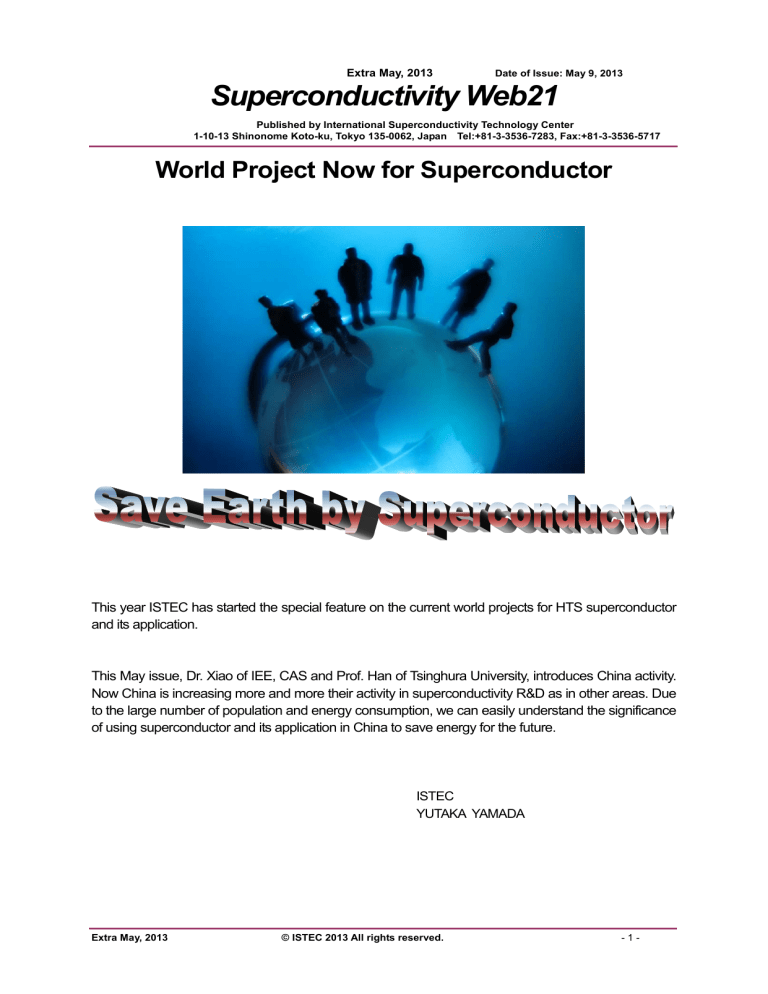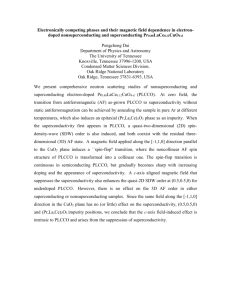Superconductivity Web21

Extra May, 2013 Date of Issue: May 9, 2013
Superconductivity Web21
Published by International Superconductivity Technology Center
1-10-13 Shinonome Koto-ku, Tokyo 135-0062, Japan Tel:+81-3-3536-7283, Fax:+81-3-3536-5717
World Project Now for Superconductor
This year ISTEC has started the special feature on the current world projects for HTS superconductor and its application.
This May issue, Dr. Xiao of IEE, CAS and Prof. Han of Tsinghura University, introduces China activity.
Now China is increasing more and more their activity in superconductivity R&D as in other areas. Due to the large number of population and energy consumption, we can easily understand the significance of using superconductor and its application in China to save energy for the future.
ISTEC
YUTAKA YAMADA
Extra May, 2013 © ISTEC 2013 All rights reserved. - 1 -
Extra May, 2013 Date of Issue: May 9, 2013
Superconductivity Web21
Published by International Superconductivity Technology Center
1-10-13 Shinonome Koto-ku, Tokyo 135-0062, Japan Tel:+81-3-3536-7283, Fax:+81-3-3536-5717
Recent Progress of Superconducting Technology for Power in China
Liye Xiao, Institute of Electrical Engineering, Chinese Academy of Sciences
Zhenghe Han, Tsinghua University
Abstract
China is a country where most of the power sources locate at the west and northwest area while most of the load centers locate at the south and east area, this distribution picture of power and load leads to a large-scale national power grid in which all regional grids are interconnected and thus the national power grid covers almost all of the territory of the country. For this reason, it has been a serious task to keep the stability and to reduce the transmission losses of the power grid. As superconducting technology would be a possible solution to enhance the stability and reduce the losses, it has been supported by the China’s
Ministry of Science and Technology (MOST) through a project named “863 Plan-On Superconducting
Technology”, and the Chinese Academy of Science (CAS). Recently, power grid companies such as State
Power Grid Company and South Power Grid Company also pay more attention on the superconducting technology for power grid. In this report, we will give a view of the recent progress of superconducting material and its application in power grid, including the YBCO tapes, BSCCO tapes, iron-based wires and the demonstration system of a 10 kV superconducting power substation, superconducting DC power cable, fault current limiter and SMES.
1. Superconducting Materials
1.1 R&D for YBCO and BSCCO in China
A coated conductor R&D project leading by Shanghai Jiao Tong University (SJTU) was supported by the Ministry of Science and Technology (MOST). At the end of 2010, SJTU successfully fabricat ed 100 m long coated conductor tape with 194 A/cm at 77 K, self field. Now 100 m long and 300
A/cm class tapes can be fabricated. Northwest Institute for Nonferrous Metal Research (NIN) has e stablished a Ni-W alloy RABiTS tape fabrication line with 30-50km/year capacity.
Bi-2223 tape is mainly produced by the company of InnoST with a capacity of 200 km/year. The s tandard long tape is of 120 A at 77 K, self field. InnoST also supplies insulated Bi-2223 tape and
Ag-Au alloy sheathed Bi-2223 tape for current leads. InnoST also supplies HTS current leads and coils to various customers.
1.2 Iron-based superconducting wires and tapes
Recently, a group leaded by Dr. Yanwei Ma at the Institute of Electrical Engineering (IEE), Chinese
Academy of Sciences first developed a PIT processing strategy to obtain c-axis textured Pb-doped
Sr
1-x
K x
Fe
2
As
2
(Sr122) tapes with Fe sheath by flat rolling. They fabricated high performance textured Sr122 tapes by optimized a cold deformation process plus Sn addition, which are both effective ways to improve grain connectivity. At 4.2 K, the J c
values showed extremely weak magnetic field dependence and reached high values of 1.7
10
4
A/cm
2
at 10 T and 1.4×10
4
A/cm
2
at 14 T, respectively, as seen in Figure 1. These values are by far the highest ever reported for iron based wires and approach the J c
level desired for practical applications. Most recently, based on the techniques used in the single-core iron pnictides wires,
Ma’s group also produced the Ag/Fe clad seven-core multifilamentary Sr
1-x
K x
Fe
2
As
2
wires and tapes, which had a high transport J c up to 2.1×10
4
A/cm
2 at 4.2 k in self field, and shows very weak field dependence at
Extra May, 2013 © ISTEC 2013 All rights reserved. - 2 -
Extra May, 2013 Date of Issue: May 9, 2013
Superconductivity Web21
Published by International Superconductivity Technology Center
1-10-13 Shinonome Koto-ku, Tokyo 135-0062, Japan Tel:+81-3-3536-7283, Fax:+81-3-3536-5717 high fields (Appl. Phys. Lett. 102 (2013) 082602). These results clearly demonstrated the strong potential of using iron based superconductors for high field applications.
Fig. 1 Transport J c
values of textured Sr122 tapes at 4.2 K plotted as a function of applied magnetic fields along with other Fe-based superconducting wires, Bi2212 and conventional Nb based superconducting wires.
2 Superconducting Technology for Power Grid
2.1 The 10kV Superconducting Power Substation [1]
The project was sponsored by IEE during last decade. The superconducting power substation was built by integration of a 3-phase 75m-long 10kV/1.5kA high T c
superconducting (HTS) power cable, a 3-phase
10kV/1.5kA SFCL, a 3-phase 10kV/0.4kV HTS transformer with capacity of 630 kVA, and a 1MJ/500kVA
SMES which have been demonstrated at substations or distribution system during 2004-2008, and then all the above superconducting power equipment were integrated at Baiyin Industrial Park of Gansu Province.
An overview of this substation is shown in Figure 2.
Since the demonstration of the substation at the beginning of February 2011, there has been neither fault in the distribution system nor electrical breakdown of the superconducting power equipment. A cryogenic fault in the refrigeration system can be recovered by replacement of cryostat of the power transformer and the
LN
2
pump. For above reason, the operation of the superconducting power substation demonstrates that reliability and power quality of the power supply have been greatly improved by the SMES.
Extra May, 2013 © ISTEC 2013 All rights reserved. - 3 -
Extra May, 2013 Date of Issue: May 9, 2013
Superconductivity Web21
Published by International Superconductivity Technology Center
1-10-13 Shinonome Koto-ku, Tokyo 135-0062, Japan Tel:+81-3-3536-7283, Fax:+81-3-3536-5717
Fig. 2 A view of the superconducting power substation
2.2 The 360m/10kA Superconducting DC Power Cable [2]
In order to demonstrate the possible application of superconductor for DC power transmission, IEE started to develop a 10 kA HTS DC power cable in 2007. In order to test the cable to carry current capacity of 10 kA, the cable is then demonstrated in Zhongfu Group which is company to produce aluminum.
The power cable now has been successfully installed at Henan Zhongfu Group in September 2012. In order to test the bending performance of the cable, the installation of the HTS DC cable is designed to be bended 9 times, among which three are vertical bending and six are horizontal bending, and the minimum bending radius is 3 m. The power cable, which connects the substation and the bus-bar of an aluminum electrolyzing workshop, now is operated to serve for the power supply of the factory together with the conventional transmission conductor. An overview of the installed cable is shown in Figure 3.
Fig. 3 An overview of the 10kA HTS DC power cable after installation.
2.3 220kV/800A Superconducting Fault Current Limiter [3]
Recently, saturated iron-core type FCL have been developed in China by Innopower Superconducting
Power Cable Company. After the factory tests in 2011, the 220kV/800A FCL was disassembled into five parts and shipped to Shigezhuang substation of Tianjin, China. Installation of the device was completed in the first quarter of 2012. Figure 4 shows the FCL after installation. Acceptance tests on this device were carried out by Tianjing Power Company. The results show that the FCL was restored to its functional capabilities after undergoing disassembling, shipment, reassembling, and installation configurations and is qualified for grid operation. Live-grid operation of this FCL will be proceeded to test its performance and reliability.
Extra May, 2013 © ISTEC 2013 All rights reserved. - 4 -
Extra May, 2013 Date of Issue: May 9, 2013
Superconductivity Web21
Published by International Superconductivity Technology Center
1-10-13 Shinonome Koto-ku, Tokyo 135-0062, Japan Tel:+81-3-3536-7283, Fax:+81-3-3536-5717
Fig. 4 A view of the 220kV/800A FCL after installation at Shigezhuang substation in Tianjin
2.4 The 1MJ/500kVA HTS SMES [4,5]
The SMES was fabricated by BSCCO tape and operated at 4.2
K. The coil for the SMES consisted of 44 double pancakes, among which pancakes at two ends were wound with single tape, and the other 38 double pancakes were wound by two tapes in parallel. Because of the anisotropic effect, 3 coils at each end were operated in parallel in order to obtain the same critical current as each of the other pancakes. The
SMES was tested at Beijing Mentougou Substation before it was moved to the 10 kV Superconducting
Substation at Baiyin City, Gansu Province. The operation of the SMES shows that the power quality can be effectively improved by SMES, an example shows that the distortion of grid current has been greatly lowered from 5.13
% to as low as 1.33
%.
2.5 The 1MW HTS Motor
A 1 MW HTS Motor (as shown in Figure 5) has been made by Wuhan Institute of Marine Electric
Propulsion by using of Bi-2223 tape. The motor employs synchronous structure of 4 HTS poles with a rotating speed of 500-rpm.
Fig. 5 A view of the 1 MW HTS motor
Extra May, 2013 © ISTEC 2013 All rights reserved. - 5 -
Extra May, 2013 Date of Issue: May 9, 2013
Superconductivity Web21
Published by International Superconductivity Technology Center
1-10-13 Shinonome Koto-ku, Tokyo 135-0062, Japan Tel:+81-3-3536-7283, Fax:+81-3-3536-5717
3. Summary
Since the superconducting power technology would be a possible solution for the stability and efficiency of
China’s power grid, the R&D on this field has been supported by the MOST, CAS and power grid company.
In last few years, it has reached significant progresses in the R&D for HTS materials such as BSCCO tapes,
YBCO tapes and Iron-based wires, and fabrication and demonstrations on superconducting power substation, DC power cable, Fault current limiter, SMES and motor have been successfully conducted in
China.
Reference
[1] Xiao L.Y., Dai S.T. and Lin L.Z. et al. (2012), Development of the World’s First Superconducting Power
Substation, IEEE Transactions on Applied Superconductivity, Vol.22, 5000104.
[2] Xiao L.Y., Dai S.T. and Lin L.Z.et al. (2012), Development of a 10kA HTS DC Power Cable, IEEE
Transactions on Applied. Superconductivity, 22, 5800404.
[3] Xin Y., Gong W. Z., Cui J.B. et al. (2013), Factory and Field Tests of a 220 kV/300 MVA Statured
Iron-Core Superconducting Fault Current Limiter, IEEE Transactions on Applied Superconductivity, 23,
5602305 (to be published).
[4] Xiao L.Y., Wang Z.K., Dai S.T., Zhang J.Y., Zhang D., Gao Z.Y., Song N.H., Zhang F.Y., Xu X. and Lin
L.Z. (2008), Fabrication and Tests of a 1MJ HTS Magnet for SMES, IEEE Transactions on Applied
Superconductivity, 18, 770-773.
[5] Dai S.T., Xiao L.Y., Wang Z.K., Guo W.Y., Zhang J.Y., Zhang, D. Gao Z.Y., Song N.H., Zhang Z.F.,
Zhu Z.Q., Zhang F.Y., Xu X., Qiu Q.Q., and Lin L.Z. (2012), Development and Demonstration of a 1MJ
High Tc SMES, IEEE Transactions on Applied Superconductivity, 22, 5700304.
Top of Superconductivity Web21
Extra May, 2013 © ISTEC 2013 All rights reserved. - 6 -



